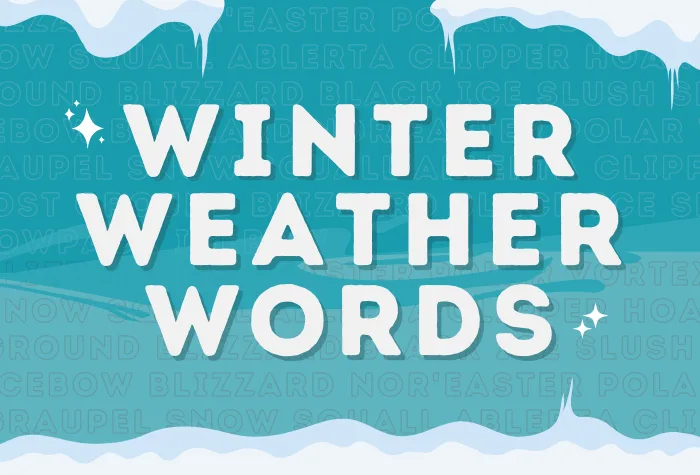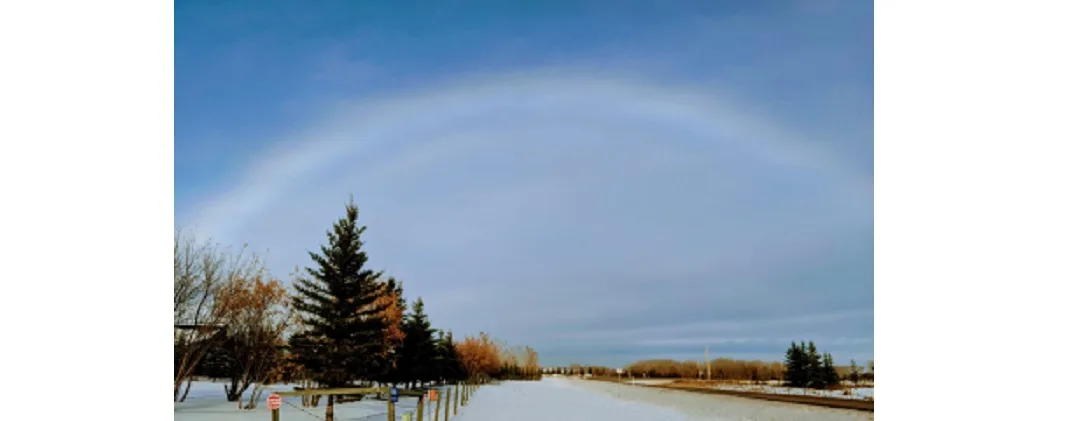
20 winter weather words you need to know
'Tis the season to brush up on your winter weather terminology.
Now that our winter forecast is in full swing, we thought it would be a good time to review some of the terms you'll be hearing this season. There are many winter weather words - far more than twenty - but there's a lot to take in here, and we thought it would make a good starting point.
Enjoy!
1. Albedo: Albedo is the measure of how well a surface reflects sunlight. Dark surfaces have a low albedo and absorb solar heat, while bright, white snow and ice have high albedos, which reflect sunlight. Because snow and ice absorb less light, they have a cooling effect on the surfaces below.
2. Alberta clipper: An Alberta clipper is a fast, low-pressure system that develops in Alberta, tracks through the northern plains, the midwest, and the Great Lakes region, usually in winter. It is often accompanied by light snow, strong winds, and cold temperatures.
3. Black ice: Black ice is a thin coating of highly transparent ice. It can be hard to see because it blends in with the pavement.
4. Blizzard: A blizzard is defined as a severe snowstorm with winds of 40 km/h or greater, which are expected to cause reduced visibility to 400 m or less due to blowing snow or falling snow, and is expected to last for at least 4 hours.
5. Freezing rain: When the rain hits a surface below freezing, it will freeze to that surface, and an icy coating will form. Popular places for freezing rain to accumulate include trees, cars, and roads.
6. Graupel: Graupel are soft, small pellets that form when supercooled water droplets freeze onto a snow crystal in a process called riming. Graupel pellets typically remain less than 5 mm in size.
7. Ground blizzard: A ground blizzard occurs when there is no snow falling from the sky, but loose snow on the ground is lifted and blown by strong winds.
8. Hoar frost: Hoar frost is a spectacular winter phenomenon that forms under specific conditions. When water vapour in the air contacts an object, like a tree branch or a blade of grass, that's below the freezing mark, it immediately freezes to form ice crystals, rather than condensing onto the object first. It is identified by its feathery structure and white or opaque appearance, and it forms in the absence of fog.
9. Icebow: An icebow is an atmospheric phenomenon resembling a rainbow, but instead of water droplets, icebows are associated with ice crystals.

(John Tsimaras/submitted)
10. Nor’easter: A winter storm characterized by northeasterly winds that hit the coast as they move through. While not all nor'easters produce snow, when they do, accumulation can be significant.
BELOW: A nor'easter filmed live on location in Grand Etang, Nova Scotia, on March 26, 2014:
11. Polar vortex: A low-pressure area parked in polar regions. In winter, the polar vortex at the North Pole expands, sending cold air south. It is often associated with frigid temperatures.
12. Rime ice: Rime ice Unlike hoar frost, which forms in the absence of fog, rime ice happens in the presence of freezing fog, which is composed of supercooled water droplets that accumulate on trees, fences, and wires, creating tiny, snowy ice spikes.
13. Sleet: Sleet is rain that freezes into ice pellets before reaching the ground. It typically bounces when hitting surfaces and does not adhere to objects, but it can accumulate like snow, causing hazardous roadway conditions.
14. Slush: Slush is partially-melted snow or ice. It can be messy, and heavy, and slippery. If you see it on the roads, be careful! Slush can create a mess of roadways, leading to delays.
15. Snow shower: A snow shower is defined as intermittent snow falling at varying intensities for short periods, leading to possible accumulation.
16. Snow squall: A snow squall is a sudden, moderate-to-heavy snowfall with blowing snow and potentially gusty winds. Two types of snow squalls are lake-effect snow and frontal squalls.
17. Snowpack: Snowpack is an accumulation of winter snowfall that remains in place until warmer weather arrives.
18. Thundersnow: Thundersnow, also sometimes referred to as a winter thunderstorm, happens when the primary precipitation falling is snow rather than rain. Sometimes this rare phenomenon will produce hail or graupel.
19. Whiteout: Whiteouts occur when heavy snow and often other factors, including strong winds, combine to create what almost looks like a "wall" of snow, making it difficult to distinguish objects or the horizon.
20. Windchill: While air temperature is a measurable atmospheric condition, windchill is a formula that accounts for the air temperature and the wind to approximate how fast your skin will cool in the given conditions. It's not a measurable value like temperature and is used as an indicator of the imminence of frostbite. That's what it means when forecasters say, "the temperature is -10°C, but it feels like -15 with the windchill." Note there is no form of measurement (like Celsius) attributed to it.
VIDEO: Let's review those winter weather words
Video production: April Walker.











